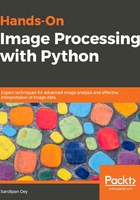
上QQ阅读APP看书,第一时间看更新
Using scipy.misc's face dataset
The next code block shows how to display the face dataset of the misc module:
im = misc.face() # load the raccoon's face image
misc.imsave('face.png', im) # uses the Image module (PIL)
plt.imshow(im), plt.axis('off'), plt.show()
The next figure shows the output of the previous code, which displays the misc module's face image:

We can read an image from disk using misc.imread(). The next code block shows an example:
im = misc.imread('../images/pepper.jpg')
print(type(im), im.shape, im.dtype)
# <class 'numpy.ndarray'> (225, 225, 3) uint8
The I/O function's imread() is deprecated in SciPy 1.0.0, and will be removed in 1.2.0, so the documentation recommends we use the imageio library instead. The next code block shows how an image can be read with the imageio.imread() function and can be displayed with Matplotlib:
import imageio
im = imageio.imread('../images/pepper.jpg')
print(type(im), im.shape, im.dtype)
# <class 'imageio.core.util.Image'> (225, 225, 3) uint8
plt.imshow(im), plt.axis('off'), plt.show()
The next figure shows the output of the previous code block:
